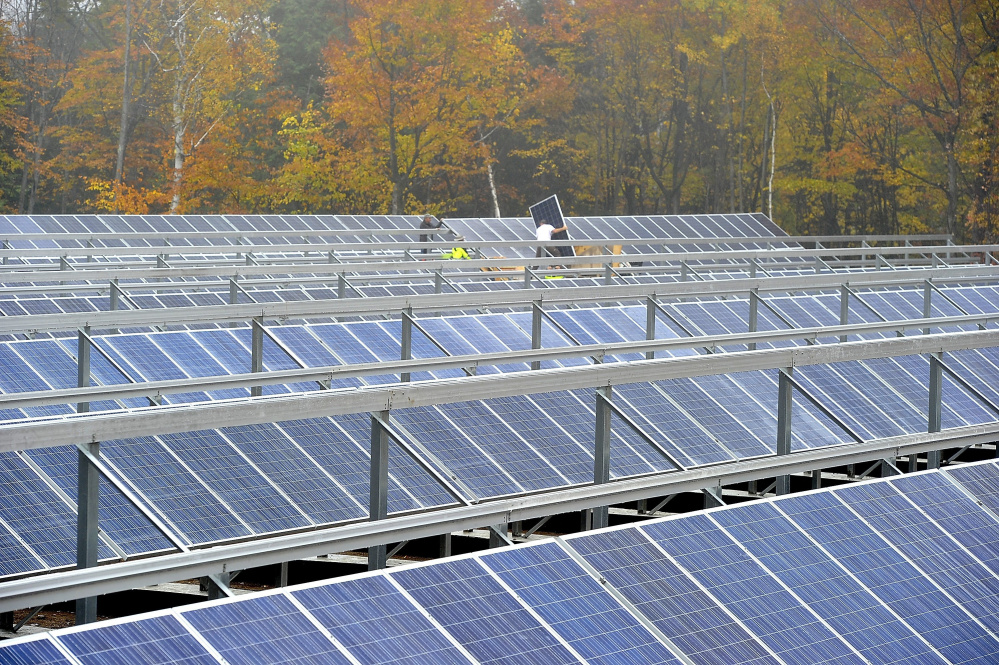The latest evidence that 2015 was a breakout year for clean energy is in, and it’s particularly telling.
In a new analysis, Bloomberg New Energy Finance finds that 2015 was a record year for global investment in the clean energy space, with $329 billion invested in wind, solar panels, biomass plants and more around the world. The number does not include investments in large hydroelectric facilities.
That’s 3 percent higher than the prior 2011 global investment record of $318 billion.
And most striking is that it happened in a year in which key fossil fuels – oil, coal and natural gas– were quite cheap.
When it comes to fossil fuels, “prices have been low, continue to stay low, and yet we continue to see strong growth of wind and solar, and it speaks to the fact that again, these technologies are becoming more cost competitive,” said Ethan Zindler, an analyst with Bloomberg New Energy Finance.
The price of oil tanked in 2015. Coal prices and U.S. natural gas prices also got considerably cheaper over the second half of 2014 and the 12 months of 2015.
Nonetheless, China and the UK invested in massive multibillion-dollar offshore wind farms, even as other nations, from the United States to Brazil, saw near billion-dollar expenditures on new solar farms and biomass plants.
Fully one-third of the 2015 clean energy investment occurred in China – a punchline we’ve come to expect by now.
That country saw investments of $ 110.5 billion last year.
The United States was second with $ 56 billion.
Notably, India – perhaps the most watched energy nation in the world at the moment, because of expectations of major demand growth – invested $ 10.9 billion, a total that Bloomberg New Energy Finance calls “a far cry for the figures needed to implement the Modi government’s ambitious plans” in the clean energy space.
India plans to install 175 gigawatts of clean energy generating capacity by 2022.
Measured in terms of electricity generating capacity, the world saw an additional 64 gigawatts of wind capacity added and 57 gigawatts of solar capacity, Bloomberg New Energy Finance estimates.
The most striking figure here is that while 2015 only saw about 4 percent more clean energy investment than 2014, when $ 316 billion was invested, the growth in renewable energy generating capacity was much higher at 30 percent.
This, again, signals declining cost, Zindler says.
“The technologies have reached an important tipping point in a number of markets in the world,” he said.
“They are now, in a growing number of locations, becoming cost competitive.”
It doesn’t hurt, of course, that government policy also favors them in many regions, a trend that will surely only continue in the wake of the late 2015 Paris climate agreement.
Overall, the addition of 121 gigawatts of solar and wind globally – also a record – means that roughly half of new electricity generating capacity installed last year was in these two technologies.
In the United States, solar appears to have seen a record year for installed capacity, at over 7 gigawatts.
From an industry perspective, too, the clean energy space seems to be thriving lately. For instance, leading wind turbine maker Vestas saw its stock price double in 2015.
And by all signs, 2016 will see more of the same. Already, it has held some pretty bad news for coal.
New York Gov. Andrew Cuomo announced, in his latest State of the State address Wednesday, plans to “eliminate all use of coal in New York State by 2020.”
That came one day after President Obama, in his State of the Union speech, suggested plans to “change the way we manage our oil and coal resources so that they better reflect the costs they impose on taxpayers and our planet,” suggesting possible policy moves to limit coal leasing on public lands in the United States.
Looking out still further, the International Energy Agency said last year that between now and 2020, renewable energy will be the largest area for growth, and predicts 700 gigawatts of added generating capacity.
In other words, while half of new generating capacity in 2015 was in the clean energy space, in coming years we may see that percentage grow even higher. Granted, there is still a ways to go before wind, solar, and other renewable energy sources are dominant in generating our electricity.
Wind and solar provide about 5 percent of U.S. electricity right now, for instance. Here, as across much of the world, electricity generation is still largely dominated by fossil fuels.
Adding it all up, the takeaway is that the race to switch off of fossil fuels – before too much carbon accumulates in the atmosphere and the planet warms by more than 2 degrees Celsius – is really starting to, um, heat up.
Send questions/comments to the editors.



Success. Please wait for the page to reload. If the page does not reload within 5 seconds, please refresh the page.
Enter your email and password to access comments.
Hi, to comment on stories you must . This profile is in addition to your subscription and website login.
Already have a commenting profile? .
Invalid username/password.
Please check your email to confirm and complete your registration.
Only subscribers are eligible to post comments. Please subscribe or login first for digital access. Here’s why.
Use the form below to reset your password. When you've submitted your account email, we will send an email with a reset code.